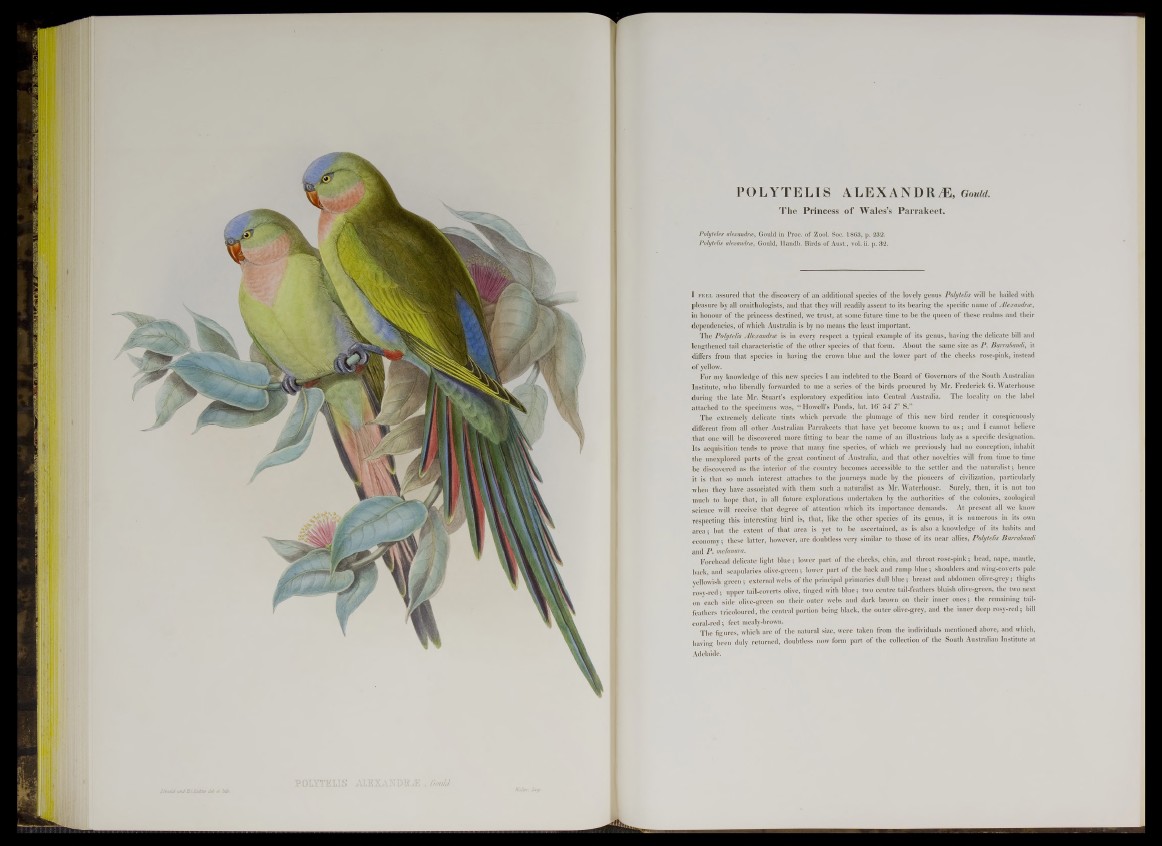
POLYTELIS AXEXAN B R J E fsould
POLYTELIS ALEXANDRA, Gould.
The Princess of Wales’s Parrakeet.
Poly teles alexandrce, Gould in Proc. of Zool. Soc. 1863, p. 232.
Polytelis alemndree, Gould, Handb. Birds of Aust., vol. ii. p. 32.
I feel assured that the discovery of an additional species of the lovely genus Polytelis will be hailed with
pleasure by all ornithologists, and that they will readily assent to its bearing-the specific name of Alexandres,
in honour of the princess destined, we trust, at some future time to be the queen of these realms and their
dependencies, of which Australia is by no means the least important.
The Polytelis Alexandres is in every respect a typical example of its genus, having the delicate bill and
lengthened tail characteristic of the other species of that form. About the same size as P . Bairabandi, it
differs from that species in having the crown blue and the lower part of the cheeks rose-pink, instead
of yellow.
For my knowledge of this new species I am indebted to the Board of Governors of the South Australian
Institute, who liberally forwarded to me a series of the birds procured by Mr. Frederick G. Waterhouse
during the late Mr. Stuart’s exploratory expedition into Central Australia. The locality on the label
attached to the specimens was, “ Howell’s Ponds, lat. 16° 54' 7" S.”
The extremely delicate tints which pervade the plumage of this new bird render it conspicuously
different from all other Australian Parrakeets that have yet become known to u s ; and I cannot believe
that one will be discovered more fitting to bear the name of an illustrious lady as a specific designation.
Its acquisition tends to prove that many fine species, of which we previously had no conception, inhabit
the unexplored parts of the great continent of Australia, and that other novelties will from time to time
be discovered as the interior of the country becomes accessible to the settler and the naturalist ; hence
it is that so much interest attaches to the journeys made by the pioneers of civilization, particularly
when they have associated with them such a naturalist as Mr. Waterhouse. Surely, then, it is not too
much to hope that, in all future explorations undertaken by the authorities of the colonies, zoological
science will receive that degree of attention which its importance demands. At present all we know
respecting this interesting bird is, that, like the other species of its genus, it is numerous in its own
a re a ; but the extent of that area is yet to be ascertained, as is also a knowledge of its habits and
economy; these latter, however, are doubtless very similar to those of its near allies, Polytelis Barrabandi
and P. melanura.
Forehead delicate light blue; lower part of the cheeks, chin, and throat rose-pink; head, nape, mantle,
back, and scapularies olive-green; lower part of the back and rump blue; shoulders and wing-coverts pale
yellowish green ; external webs of the principal primaries dull blue; breast and abdomen olive-grey; thighs
rosy-red; upper tail-coverts olive, tinged with blue; two centre tail-feathers bluish olive-green, the two next
on each side olive-green on their outer webs and dark brown on their inner ones; the remaining tail-
feathers tricoloured, the central portion being black, the outer olive-grey, and the inner deep rosy-red; bill
coral-red; feet mealy-brown.
The figures which are of the natural size, were taken from the individuals mentioned above, and which,
having been duly returned, doubtless now form part of the collection of the South Australian Institute at
Adelaide.